 |
 |
| A tapestry embroidered with verses from the Qur’an hangs on the wall outside the examination rooms at the clinic. Below: Outside the clinic that first opened its doors in 1996, staff and volunteers take a morning break in the California sunshine. |
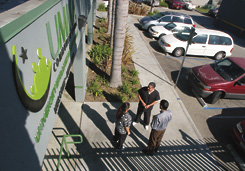 |
Written by Pat McDonnell Twair
Photographed by Ben Tecumseh DeSoto
“You’re only students.”
That was the reaction from community leaders in 1992 when Rushdi Abdul Cader and six med-school friends proposed offering free medical services in South Central Los Angeles, then recently ravaged by riots.
What made the proposal even less plausible was that the seven, all members of the Muslim Students Association (MSA) at the University of California at Los Angeles (UCLA), had no money—and it would be years before they received their degrees.
 onetheless, four years later, with the encouragement of their professors and Los Angeles City Councilwoman Rita Walters, the indefatigable idealists opened the first charity health clinic in
the United States founded by Muslims. They named it UMMA, an acronym for “University Muslim Medical Association” and the Arabic word for “community.”
onetheless, four years later, with the encouragement of their professors and Los Angeles City Councilwoman Rita Walters, the indefatigable idealists opened the first charity health clinic in
the United States founded by Muslims. They named it UMMA, an acronym for “University Muslim Medical Association” and the Arabic word for “community.”
According to co-founder Mansur Khan, MD, UMMA’s roots actually go back to 1986. That was the year the MSA elected a president named Ali Galedary, an Iranian–American who had grown up in one of Los Angeles’s Mexican–American working-class communities and who had volunteered in a
gang-intervention program. “Up to then, the MSA had been strictly a social organization,” Khan says. “Ali persuaded many of us to work as mentors and tutors to incarcerated teens
in a Ventura facility. He told us, ‘We have manpower and ability—let’s do something serious.’”
Initially, the seven considered raising funds for a mobile health unit.
“Our objective was to make an impact on the well-being of the people of South Central as well as on our Muslim community,” Khan continues. “We didn’t see much social
activism on the part of the first-generation Muslims, our parents, who were concerned about preserving their cultural identity and establishing Islamic religious and educational
institutions.”
 |
| Steven Murphy, MD, medical
director at UMMA, examines a young patient. |
“The 1992 riots were a catalyst,” says Abdul Cader. A supportive professor helped the students take their idea to the Los Angeles City Council, where South Central Councilwoman Rita
Walters told them, “Forget the trailer. I’ll find you a building for a permanent clinic.”
Los Angeles County is three times the size of the state of Rhode Island and a third the size of the Netherlands. It is home not only to billionaires in Bel-Air and Beverly Hills, but also to some 900,000 people in the South Central region
who endure poverty and widespread homelessness.
The sky was still hazy from fires set during the riots following the trial of Rodney King’s attackers when the UCLA students began driving to South Central to search for a
building.
“We learned not to drive too slowly,” Abdul Cader recalls. “We found out that gangbangers drive slowly into each other’s territory when they’re looking for
trouble.”
Councilwoman Walters announced she had located “the ideal site”—a boarded-up building on Florence Avenue, just two blocks from where the 1992 riots began.
“It was an eyesore,” Abdul Cader recalls, “a derelict building with exposed wires and asbestos in the ceiling.” Worse, there were toxic deposits left from when the site
served as an auto-repair shop. But with Walters’s support, the city cleaned up the toxins and another co-founder, Altaf Kazi, recruited his architect father, Mohammed Yusuf Kazi, to design
the future clinic.
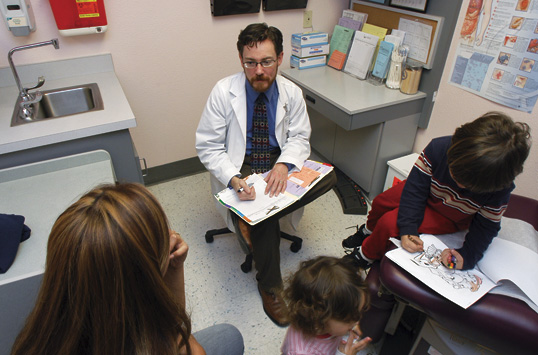 |
| Dr. Murphy consults with a young mother. |
“I remember weeds and graffiti, drug paraphernalia and liquor bottles everywhere,” says Kazi. “We took the structure down to its studs. My father drew up the blueprint for six
exam rooms, a waiting room, a pharmacy and a large staff conference room.”
Over the next three years, the students asked medical suppliers to donate examination tables, lamps, chairs and filing cabinets. While they waited for construction to end, they used their family
garages and patios for storage.
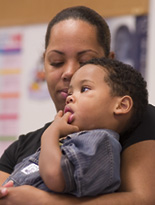 |
| The face of Noelle Levingston shows concern for her son Devin, 3, while they sit in the waiting room. |
The students also raised more than $1.3 million in grants, and in September 1996 UMMA opened its doors. Today, the clinic runs on an annual budget of $1.5 million that comes from fundraising,
grants and state and county reimbursements for indigent care.
Abdul Cader, who was just beginning his internship as an emergency-room doctor when UMMA opened, served as the clinic’s first medical director. Raziya Shaikh was its first manager. (She left to pursue a Ph.D in biology.)
“We turned a health hazard into a health center,” Abdul Cader says proudly. “We accomplished all this because we had a window of time, before opening our practices and starting
families, in which we could devote a lot of our energies to the clinic.”
When the students distributed flyers announcing the opening of the clinic, their neighbors at first were skeptical. Some feared it was a government attempt to keep track of illegal immigrants.
Others voiced doubts that a student operation would be permanent. “After you finish your research, you’ll leave,” they predicted.
“Within a few months, the people realized we weren’t about ‘diagnosing and adios-ing,’” says UMMA president and CEO Yasser Aman. “We take our role seriously:
to serve one of the poorest communities in the country. South Central has the highest rates in the country of premature births, foster children, child abuse and people without health insurance.”
Making Doctors
“We don’t just treat patients at UMMA,” states co-founder Khaliq Siddiq, MD. “We actually make doctors here.”
He was referring to UMMA’s role as a teaching site for more than 200 medical students who have trained at the clinic in the past 10 years. This aspect of UMMA’s work is
overseen by Rumi Abdul Cader, MD, director of medical education at UMMA and an associate professor of medicine at UCLA’s School of Medicine.
“The student program is the heart and soul of UMMA,” says Abdul Cader, who notes that UMMA is one of the most popular community rotations for UCLA medical students.
“It’s chiefly third-year medical students who come to UMMA,” he explains. “UMMA is a teaching model which exposes medical students to the needs of the
underserved. Hopefully, they develop cultural sensitivity in understanding the unique medical and social issues of the inner-city poor.” |
In that first year, UMMA treated a total of 800 patients. Today it serves about 6500 a year. And it’s safe: The clinic and its grounds have been untouched by local gangs. One patient noted: “I feel like UMMA is a safe haven, a little bit of heaven in chaos.”
Within one year, UMMA decided it didn’t need a security guard. Neighbors assured the staff, “Don’t worry, we take care of this clinic.”
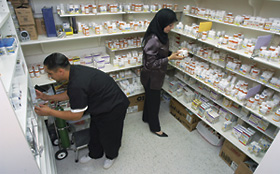 |
| Pharmacy technician Rafael Gomez and volunteer doctor Naima Frewam, who was
born in Libya, work in the pantry that stocks donated medicine. Below: A certificate in the hall commemorates the national recognition UMMA received in 2006 in the US House of Representatives from
Congresswoman Maxine Waters, who represents South Central. “If you want to see what Muslim Americans truly represent, go to UMMA Clinic,” she said. |
 |
Aman explained that UMMA serves as a health “safety net” for some 15,000 patients who are uninsured, indigent or simply members of the “working poor.” Some 70 percent of
UMMA’s patients are Latinos; fewer than five percent are Muslims.
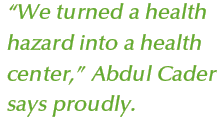
“The doctor-patient ratio in South Central is one physician for 29,000 people, while in Beverly Hills, it’s five doctors to one person,” Aman says. “The customary wait to
be seen in the Los Angeles County health system, for patients with serious diseases, is six to nine months.” In addition to UMMA’s staff of 15, there is a pool of 20 volunteer
physicians and a referral coordinator who counsels patients and sets up appointments with specialists, especially for diabetes and high blood pressure, which Aman calls “the silent killers we
identify here.” Overall, about one-third of the care given at UMMA is to children.
Pediatrician and co-founder Nisha Abdul Cader, Rushdi’s wife, remembered how, during the first year, she examined a 12-year-old girl who was wasting away. “Other clinics had examined
the child, but failed to diagnose her illness. I tested her for hiv, and she was positive. I learned she’d had a blood transfusion when she was born prematurely.” She sent the child to
Harbor-UCLA Medical Center, and today she’s a student at the University of California at Davis.
Another UMMA success story deals with an uninsured father who struggled from paycheck to paycheck while suffering from an unknown ailment. His daughter had noticed the UMMA clinic sign and urged
him to make a call there. He was diagnosed with ulcerative colitis, a potentially serious disease of the colon that can increase the risk of cancer. Today, with proper care, his disease is under control.
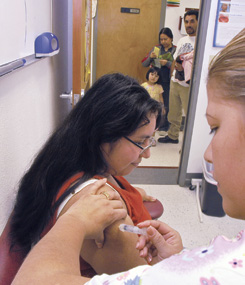 |
| Nidia Aparicio, 16, receives a booster shot as her family peers from the hallway door. The clinic is one of the few locations in the neighborhood where families can get the free
immunizations required to attend public schools. |
On designated Saturdays, UMMA offers health fairs in its parking lot, conducting blood drives and offering diabetes and blood-pressure screening. Last February, it even held workshops on preparing tax returns.
Speaking in the US House of Representatives last July, Congresswoman Maxine Waters, who represents the South Central area, said, “If you want to see what Muslim Americans truly represent,
go to UMMA Clinic, and you’ll see it there. The students who founded UMMA were inspired by their Islamic faith, a faith which told them to help the neighbor, a faith which told them that if they saw something wrong, they must fix it.” In the presence of UMMA founders and supporters in the gallery, Waters went on to say that UMMA serves as a primary health-care source for more than 15,000 people in her congressional district, many of whom would otherwise have no access to primary health care services at all.
The clinic’s success stories are spreading, and UMMA has received calls from Muslim groups in the California cities of San Bernardino and Sacramento, as well as from Detroit, Las Vegas,
Houston and Raleigh, North Carolina. All are looking for guidance in establishing similar clinics; one is also starting up in Columbus, Ohio.
Other local social-service agencies respect UMMA’s role. The executive director of the non-profit Esperanza Community Housing Corporation, Nancy Halpern, says, “I’ve witnessed how vital UMMA, this self-made gem of a health clinic, is as a provider of primary health care. It’s also a responsible link to specialty health care for people who are largely uninsured,” she adds.
 |
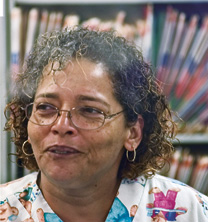 |
| Left: Through an annual breakfast served in the clinic’s parking lot, Hoori Sadler, who manages her family’s own medical group in
Beverly Hills and is one of UMMA’s top volunteers, has raised more than $700,000 for the clinic. “UMMA is in my blood. If you are a good Muslim, you give without being asked,” she
says. Right: Eleanor Mateo runs the clinic’s front desk. |
Similarly, Jim Mangia, CEO of St. John’s Well Child and Family Center, comments that “I don’t know what would happen to thousands of patients if UMMA weren’t
here.”
In 1999, UMMA received the Best Practices Award from the Department of Housing and Urban Development. In 2005, Kaiser Permanente bestowed on UMMA its National Community Service Sabbatical
Award.
But far more than such awards, UMMA medical director Steven Murphy values the thanks of the clinic’s patients. Many express their gratitude verbally, in Spanish or English; others,
however, turn to the universal “thank you” of food: “They often bring us hot tamales, or a big pot of soup, and even fish caught off the Santa Monica pier,” he says.
UMMA's Founders-Now
| “I think people we asked for help reacted to our optimism and opened doors for us.” —Nisha Abdul Cader |
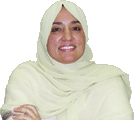 |
|
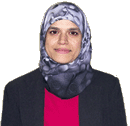 |
“In the early days of serving as the first manager, I pushed a button and minutes later five police cars were in the parking lot. I’d pushed the emergency alarm!” —Raziya Shaikh |
|
| “UMMA Clinic was an eye-opener for me. It made me more socially aware of the diverse cultures in Los Angeles.” —Aisha Siddiq |
 |
|
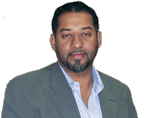 |
“We transformed a health hazard into a health center.” —Rushdi Abdul Cader |
|
| “UMMA’s focus is not just on treating disease, but promoting health from infancy on up.” —Altaf Kazi |
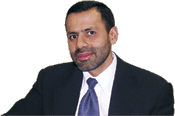 |
|
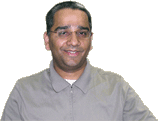 |
“We don’t just treat patients, we actually make doctors here.” —Khaliq Siddiq |
|
| “UMMA is a safe haven in a high crime area.” —Mansur Khan, incoming chairman of the UMMA Clinic board of directors |
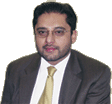 |
|
|
 |
Pat McDonnell Twair (sampat@cyberonic.com) worked for six years as a journalist in Syria. Now based in Los Angeles, she is a free-lance writer
who specializes in Arab–American topics. |
 |
Ben Tecumseh DeSoto (zendfoto@hotmail.com) is a career photojournalist who recently marked his 25th year at the Houston Chronicle, the daily
newspaper in his hometown. |